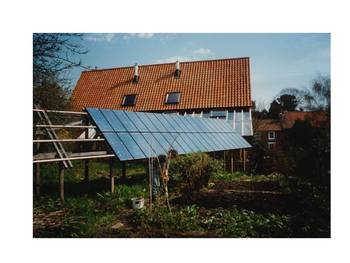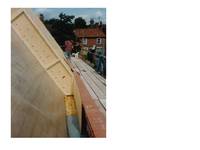By Gregory Teo

The first autonomous house in Southwell, UK.
In the small town of Southwell in Nottinghamshire, England nestles the first autonomous house in the United Kingdom. Completed in 1993 and designed by professor of architecture with the University of Auckland, green activist and author Brenda Vale, this house makes use of all the natural elements that fall on it.
Solar heat is captured in its giant conservatory to keep it warm during the English winter while triple glazed windows ensure no heat escapes. Electricity is harnessed through installed 2.2 kW photovoltaic arrays with the surplus exported to the national grid. Water is collected off its roof and the sewage is treated in a waterless and odourless composting toilet.
The building of this self-sufficient house is documented in her book The New Autonomous House: Design and Planning for Sustainability that was co-authored with husband and fellow architect Richard Vale. The book provides a manifesto on how to build a home that doesn’t pollute the earth or squander its resources.
Buoyed by her success, Brenda proceeded to design a larger cluster of five self-sufficient houses in the Hockerton Housing Project, also in Nottinghamshire. Built in 1997, the cluster requires no heating and uses lower-than-normal energy consumption that is supplied by onsite renewable energy generation from two 6 kW turbines and 7.6 kW solar panels.

Odourless, waterless composting toilet.
It collects all of its own water for both potable and non-potable usage, while waste is environmentally degraded to a solid compost heap and a liquid portion, which is slowly returned to the surrounding lake after 100 days through a geotextile baffle.
Brenda believes that houses used to be built with sustainability in mind, and her efforts are geared towards that. Brenda says, “People made use of the resources available to them when building houses in the past. We just lost that and it is what we want to recapture if we moved towards sustainability.”
“Today, you pretty much see the same apartment blocks whether you’re in Jakarta, Hong Kong, Singapore, or China. However, if we went to these places a hundred years ago, we’d see different houses because the different climate and resources determined the way houses were built,” she adds.
Why promote sustainability

Water collected off the roof is re-used.
In order to continue living on this earth without putting strain on it, we have to manage its resources with sustainability in mind—which means we might have to grow things. “People have to be in charge of their resources. If you have a vegetable garden, you’d tend to make sure you use all of it. You won’t waste anything if it’s your responsibility. Surplus would be given away rather than wasted,” says Brenda. “However, if you buy food from the supermarket you won’t know the effort that’s gone into it. You just throw away things you cannot finish,” she says.

Space heating not needed with super insulation.
Mass production is not necessarily more efficient; what it does is it adds stages so that specialization makes the work mechanical and easier to do. Brenda says, “You make the product, then process, warehouse, distribute, and retail it. All those different stages require energy and resources. Although it appears to save time to consumers, it might not save time, energy or resources overall.”
She highlighted this with an example of how she used to grow 75% of her food source. “It took us two hours a day to do that. It would have taken us four hours instead to earn the money to buy that amount of food,” says Brenda.
Simple living is thus the sustainable way forward. “There is happiness in being satisfied with what you have and I don’t think sustainability and consumerism can work together. We’ve seen the consequence of that within the last few weeks with the financial crisis as people lived beyond their means,” says Brenda.

Brenda Vale on simple living.
“During my parent’s time, the only debt we had was the mortgage. Everything else you saved up for. You lived within your means. Now, people are living on credit with the thought of supporting their spending by working in the future. Ultimately that’s what led to the financial crisis,” she adds.
Building houses with the future in mind
Building autonomous houses from scratch is easier than most people realise. “It doesn’t cost more than ordinary houses. You just spend the money during the construction in different ways,” says Brenda. At the same time, existing houses can also be converted to eco-friendly lodgings.
Hockerton housing project is designed to work in harmony with Gaia.
On replicating the building of self-sufficient houses on a larger scale, she says, “In China, I’ve seen apartment blocks with rows of solar heater on the roof. I’ve also witnessed water collected on the glass facade of a commercial building for non-potable use such as flushing toilets.”
“It’s not difficult to build houses that sustainably harness the natural environment but people need to realise that they can do it. Examples of autonomous houses help show people that things can be done differently so that they start thinking about change,” says Brenda.
Especially now when people are over-taxing the resources of the Earth, Brenda’s message of self-sufficiency and living within one’s means will help restore and rejuvenate precious natural resources.
Brenda Vale was an invited speaker at the Futuropolis 2058 conference in Singapore: Creating Sustainable Urban Environments through Innovation. Browse the book The New Autonomous House: Design and Planning for Sustainability by Brenda Vale and Robert Vale here.
